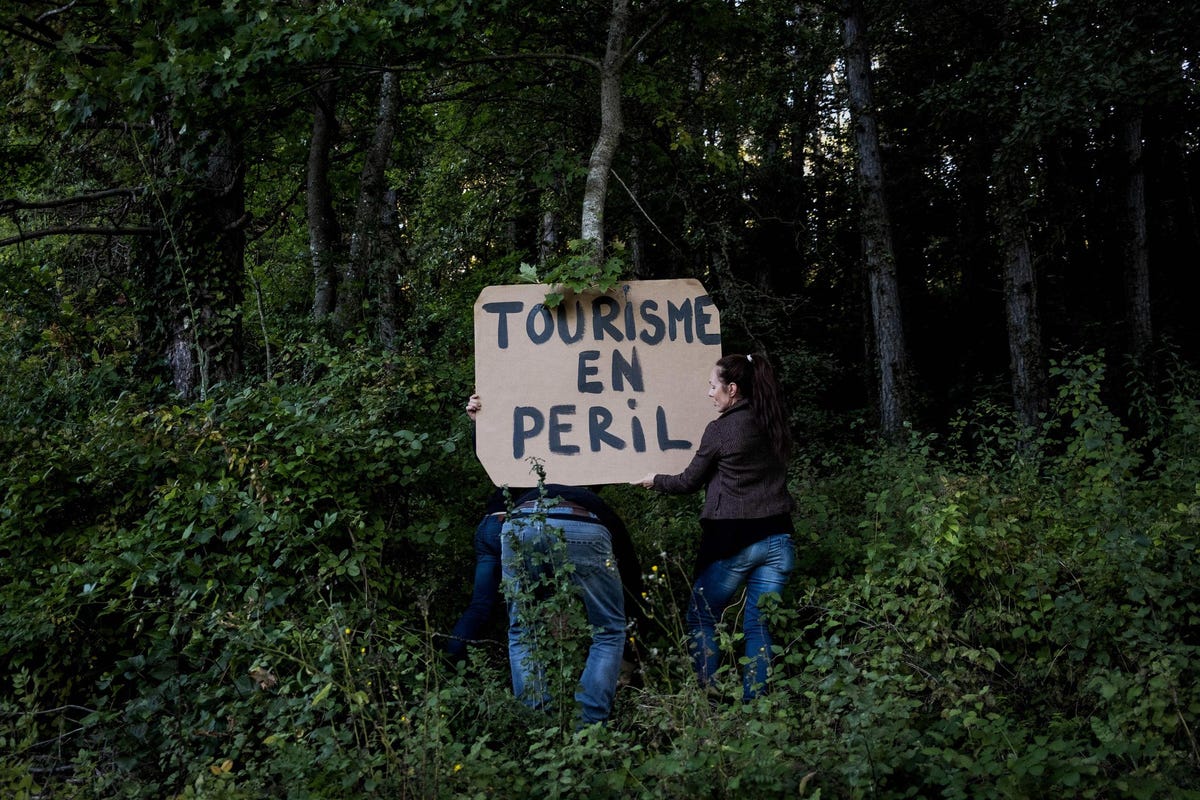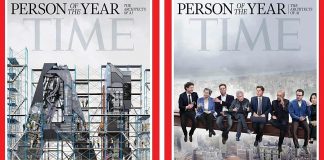Local residents install a banner reading ‘tourism in danger’ near the Chateau de La Rochepot, a … [+]
AFP via Getty Images
“Nobody goes there anymore. It’s too crowded.” So said the great American sage and Hall of Fame Yankee baseball player Yogi Berra. And that is what can very easily happen to world tourism, with COVID-19 used as an excuse.
Millions of people are anxious to see the world and are willing to pay to do so. And after two years of Zoom, Teams and Netflix, video is not good enough.
Tourism is in a lull right now, to put it kindly. Most people planning to travel for the holidays or New Year have already made their plans. Interestingly, Portugal and even “over-touristed” Spain (“Spain will make your heart sing again” are making their pitch. Unfortunately, the latest COVID variant, Omicron, is striking fear into the hearts of governments, travel providers and weary would-be travelers alike.
But if COVID were magically to disappear tomorrow, the travel industry would still be in trouble. Many people now hate tourism. Others happily point to how the pandemic’s “decline in transportation activity” drove a global 2.4 billion ton drop in carbon emissions.
“Climate change is a serious problem and tourism contributes a lot to it, but I don’t want to be flight-shamed out of my travels, because I think travel is a powerful force for peace and stability on this planet,” controversial travel writer Rick Steves told the New York Times. On Twitter, one reader responded, “Leisure travel is not worth the expenditure of CO2.”
Yes, tourism can damage priceless world heritage sites, crowd cities, roads, and parks and create pollution. Tourism can also raise apartment rental prices beyond the ability of locals to pay (a common complaint about Airbnb) and otherwise impact the quality of life.
A protesters carries a banner that reads ‘Tourist flats displace families’during a demonstration in … [+]
Getty
But tourism can also bring the world closer and help people of diverse cultures better understand each other. The benefit is not just to the tourist, but to residents who often can earn a living from tourism.
Travel and tourism are quite fragile now. A hoped-for summer of international ‘revenge travel’ failed to materialize as many nations continued to quarantine against the COVID-19 virus. The US ban on international travelers continued through November, as the Delta variant rampaged around the world.
Fortunately, drug makers and the logistics chain, including lift provided by air freight, made vaccines available to billions of people. Over 55% of the world’s population is now vaccinated.
Lower COVID rates made people more confident to travel. On November 28, the TSA screened the most passengers (2.45 million) in a day since the beginning of the pandemic almost two years ago.
Then word of yet another COVID variant, Omicron, drove down the stock prices of travel providers. The fragility of the travel industry, and its vulnerability to COVID-driven fear, was clear. Also clear: an increasing ambivalence about the value of tourism.
Before COVID, some areas were indeed over-loved. Cities and wilderness areas alike groaned under the weight of tourists tramping through. Hawaii, Venice, Barcelona, and Dubrovnik, particularly after GAME OF THRONES, are all examples.
DUBROVNIK, CROATIA Tourists look at ‘Game of Thrones’ paraphernalia for sale on April 27, 2019 in … [+]
Getty Images
Every municipality, state or nation has the right to decide how much tourism is too much—or too little. But to concentrate on the negative impact of tourism ignores how travel has improved lives and increased appreciation of distinct cultures and regions.
Last year the Guardian published an influential story on the end of tourism. It noted, “The pandemic has devastated global tourism, and many will say ‘good riddance’ to overcrowded cities and rubbish-strewn natural wonders.”
This year the same publication ran a story “‘No One Comes Here Any More’: the human cost as Covid wipes out tourism.”
These two stories, set side by side, show the problem plainly. Tourism has its downsides but creates jobs in both developing and developed countries. Often those jobs provide an opportunity for people with limited education or job skills to succeed. In tourist mecca Las Vegas, for example, “the power of the hotel workers union…transformed dead-end jobs into middle-class careers.”
Future Business Journal noted (pre-COVID) that “Tourism has become the world’s third-largest export industry after fuels and chemicals, and ahead of food and automotive products…With more than one billion tourists traveling to an international destination every year, tourism has become a leading economic sector, contributing 9.8% of global GDP and represents 7% of the world’s total exports.”
Tourists do not come to a country because it is underdeveloped. They come because they believe it is beautiful, or unusual, or historic, or challenging, or in some way different from home.
Earlier this year, the governor of Hawaii asked tourists to cancel their trips, citing COVID. Hotels were scarce and rental cars unavailable. Travelers rented U-Haul trucks to see the islands. And when the government suggested it made sense for tourists to stay home, it seems people with no sense were the ones who went.
But there are intimations that Hawaii does not want tourists to return, at least in the same numbers. A recent survey found 52% of residents wanted the number of tourists limited and 78% would like to see visitors charged entry fees to parks and other sites.”
In an article from earlier this year titled “I love Hawaii, but I’m not going back anytime soon,” Clint Henderson of the Points Guy laid out the issues, including traffic congestion, higher prices, and inappropriate behavior. He noted “In 2019, Hawaii got a majority of its private income from tourism, including more than $2 billion in tax revenue, but the economic benefits don’t always translate to good quality of life for Native Hawaiians.”
HONOLULU, HI – OCTOBER 15: State officials checked to be sure all arriving visitors and residents … [+]
Los Angeles Times via Getty Images
It is true that a tourist economy might not pour as much money into an area as say, Wall Street or Silicon Valley (each with its own issues.) Yet tourists patronize local and international businesses, including airlines, hotels, home-sharers, and car rental providers. Many local residents rent their homes through Airbnb or VRBO, drive tourists around through Lyft and Uber, or rent their vehicles through Getaround. Then there are the restaurants, shops, transportation and activity providers like guides, bike rentals and boat trip operators.
Tourism also supports local government, through income tax paid by employed people, property tax paid by businesses like hotels and malls, and sales tax paid on goods and services bought by travelers. There are user fees as well as hotel occupancy tax, plus airport and rental car taxes and fees.
Still, Hawaii residents are frustrated and angry at what they see as over-tourism. In Barcelona, the mayor, Ada Colau, said the residents were being sacrificed on the “altar of mass tourism.” Indeed, in 2019, Spain had more than 125 million visitors, more than 2.5 times the country’s total population of 47.1 million people. Yet the crowds contributed cash; in 2019, Spanish tourism GDP surpassed 150 billion euros.
Can a balance be struck between the needs of residents and the desires of people locked in their homes to see other places? And can countries that seek to limit the excesses of tourism offer their citizens economic alternatives?
For two years, such concerns were muted by the pandemic. But they are returning anew as the battered tourism industry tries to recover.
06 December 2021, Baden-Wuerttemberg, Freiburg: A container in which Corona rapid tests are carried … [+]
dpa/picture alliance via Getty Images
Unlock the world’s wonders with unforgettable journeys tailored just for you! Whether you crave sun-kissed beaches, thrilling adventures, or rich cultural escapes, your dream destination awaits. Enjoy seamless travel with expert tips, exclusive deals, and handpicked experiences that Turn Every Trip into a lifetime memory.










